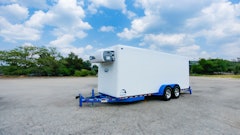
The size of the United States and its diversity of climates, soils and rainfall/irrigation helps provide a wide variety of crops to be grown from coast to coast. Fruits and vegetables are grown from sea to sea, harvested and then shipped to markets nationwide and internationally.
During produce season, trucks and trailers are needed to move fresh fruits and vegetables quickly from the fields to food processors/manufacturers or directly to the nation’s supermarkets.
For the U.S. trucking industry, spring and summer are often periods of tightened capacity, increased rates and scheduling constraints for various shippers particularly those that ship products in refrigerated trucks (reefers).
In particular, refrigerated transportation will be at a premium during produce season, and reefers may be difficult to secure if shippers are not working with the right carriers or brokers. While the cost of reefers is likely to spike during produce season, shippers should lock in capacity in advance, or adjust their carrier network accordingly.
While produce season can strain the reefer supply, it also can impact the cost to haul in dry vans. Reefers that haul dry freight switch to better-paying produce loads. Historically, DAT data shows that both dry van and reefer spot rates peak around July 4.
What is produce season, and what are its impacts?
Each year, as winter fades and temperatures rise, the North American trucking market is impacted by fresh produce season. Produce season is a short-term, planned surge in shipping volume that begins in early spring as the first fruits and vegetables are ready for harvest.
The earliest harvests begin in Mexico; produce is imported into the United States beginning in February. In addition, South American fruits and vegetables are harvested and shipped (primarily by air) to Philadelphia, then distributed nationwide. The produce wave then begins in the Southeast, southern Texas and the Rio Grande Valley, and then moves to southern California in late March. Afterward, harvests move northward as temperatures rise.
The term “produce season” is a misnomer, since there are actually a series of produce seasons that impact different areas. Produce season encompasses the nation from Florida oranges to California lettuces to Washington apples and the many other fruits and vegetables grown nationwide.
As produce harvests move from region to region, they cause seasonal shipping spikes that then create supply dislocations in those regions and perhaps throughout the country. Additionally, spot rates for reefers and dry vans in and out of regions become much more volatile.
While disruptions in specific areas are generally short-lived, other peaks can extend longer. The time when volumes peak depends on latitude and the crop(s) grown in an area.
Produce season can have a widespread impact on truckload market supply and demand. Produce season not only affects produce shippers and shippers of other foods and beverages. As trucks move into produce-shipping regions to take advantage of short-term rate spikes, capacity can be affected market-wide.
As the second quarter begins, produce harvests in northern Florida, Georgia, northern Texas, New Mexico and southern California begin. Those areas are followed by the Carolinas and northern California, then the Northeast, Midwest and Pacific Northwest.
How produce season impacts rates
Because crop volumes increase during spring and summer and because of the time-sensitivity of shipping fresh produce transportation demand rises while available capacity shrinks. Reefers are highly sought after and shippers pay higher rates to secure them.
Spot market freight volume typically rises about 30% in the spring. This sets the tone for other modes as well. In response to higher refrigerated capacity demand, dry van carriers, less-than-truckload carriers and railroads also push for rate increases.
Produce season can be a lucrative time for carriers, and some trucking companies reposition tractors and reefers to produce-heavy states when demand for them is high. As a result, even shippers in non-produce-heavy regions are impacted by capacity shortages and higher rates. The U.S. Department of Agriculture’s (USDA) Specialty Crops National Truck Rate Report tracks capacity shortages weekly in the major growing regions, which can give logistics professionals supply and demand information. The USDA report generally aligns with DAT data on truck demand.
Planning for success
Whether shipping produce or other refrigerated goods, the most important thing a shipper can do to mitigate produce season disruption is to plan well in advance. Shippers should contact their brokers and carriers to ensure forecasted needs can be covered.
Produce season can impact consumer packaged goods shippers when carriers begin diverting trucks to move high-value crop volumes. Diverting this volume will tighten capacity, drive up rates and create challenging conditions for shippers that don’t prepare for seasonal supply chain disruptions. Sound forecasting can help. In addition, shippers should measure carriers’ performance during produce shipping peaks.
Cost controls when headhauls become backhauls
As reefer demand shifts with different crop harvests, shippers may experience headhaul rates (the higher rate in a pair of moves) that become seasonal backhaul rates.
Seasonal demand can flip rates on the Atlanta to Miami lane in the spring. Miami is a backhaul market (more freight goes in than out) for most of the year, but the southbound trip can become the backhaul lane during produce season.
On that lane (and many others) shippers may be forced to pay much higher rates to cover their loads. These tips help control costs and secure reliable transportation during produce season:
- Analyze market rates.If a carrier quotes a rate that seems unusually high, examine market rates and the load-to-truck ratio for the return trip. In addition, do not undervalue carriers’ service. Poor service can cause delays or missed appointments, which can cost even more than the amount paid to a more reliable carrier.
- Arrange time-specific contracts now. If shippers have regular runs on lanes affected by produce season, they should consider setting up time-specific contracts with dedicated carriers before the end of the first quarter. Locking in quarterly or annual rates now can help save money in the long run.
- Study harvest schedules. Shippers (or the brokers they work with) should check the USDA or other produce industry websites regularly to determine which regions are becoming busier due to harvests. Researching seasonality can help shippers plan for fluctuations more effectively.
- Be (or become) a “Shipper of Choice.” Shippers should make their businesses more attractive to carriers. Why? Positioning the company as easy to do business with can be very advantageous when carriers are selective about the freight they move. A shipper can offer ways to maximize driving time, allow flexible shipping hours or emphasize driver-friendly facilities.
- Forecast accurately. Carriers appreciate shippers or brokers that help them plan ahead as much as possible. Providing carriers with accurate volume forecasts makes it easier for them to execute commitments.
Shippers should work with a trusted brokerage and carriers to lessen the impact of produce seasons. Also, shippers can work with DAT to help mitigate the cost of produce season and potential disruptions to their networks.




















